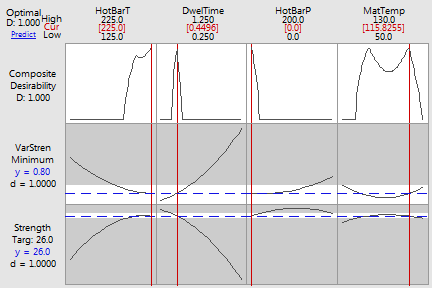main topic interpreting results session command see also
You need to create a product that satisfies the criteria for both seal strength and variability in seal strength. Parts are placed inside a bag, which is then sealed with a heat-sealing machine. The seal must be strong enough so that product will not be lost in transit, yet not so strong that the consumer cannot open the bag. The lower and upper bounds for the seal strength are 20 and 32 lbs., with a target of 26 lbs. For the variability in seal strength, the goal is to minimize and the maximum acceptable value is 1.
Previous experimentation has indicated that the following are important factors for controlling the strength of the seal: hot bar temperature (HotBarT), dwell time (DwelTime), hot bar pressure (HotBarP), and material temperature (MatTemp). Hot bar temperature (HotBarT) and dwell time (DwelTime) are important for reducing the variation in seal strength.
You goal is to optimize both responses: strength of the seal (Strength) and variability in the strength of the seal (VarStrength).
You do not need to analyze these response surface design models. The worksheet contains the models for the response optimizer.
1 Open the worksheet RSOPT_MODEL.MTW.
2 Choose Stat > DOE > Response Surface > Response Optimizer.
3 For VarStrength, choose Minimize.
4 For Strength, choose Target and enter 26.
5 Click Setup. Complete the columns of the table as shown below, then click OK.
|
Response |
Goal |
Lower |
Target |
Upper |
Weight |
Importance |
|
VarStrength |
Minimize |
0.8 |
0.8 |
2.3354 |
1 |
1 |
|
Strength |
Target |
24 |
26 |
28 |
1 |
1 |
6 Click OK in each dialog box.
Session Window Output
Response Optimization: VarStrength, Strength
Parameters
Response Goal Lower Target Upper Weight Importance VarStrength Minimum 0.8 2.3355 1 1 Strength Target 24 26.0 28.0000 1 1
Solution
VarStrength Strength Composite Solution HotBarT DwelTime HotBarP MatTemp Fit Fit Desirability 1 225 0.449575 0 115.826 0.800000 26.0000 1.00000
Multiple Response Prediction
Variable Setting HotBarT 225 DwelTime 0.449575 HotBarP 0 MatTemp 115.826
Response Fit SE Fit 95% CI 95% PI VarStrength 0.80 2.33 (-4.13, 5.73) (-4.70, 6.30) Strength 26.00 8.95 ( 7.03, 44.97) ( 4.86, 47.14) |
Graph Window Output

The individual desirability of both the seal strength and the variance in seal strength is 1.0. Therefore, the combined or composite desirability of these two variables is 1.0.
To obtain this desirability, you would set the factor levels at the values shown under Solution. That is, hot bar temperature would be set at 225.000, dwell time at 0.449575, hot bar pressure at 0, and material temperature at 115.826.
If you want to adjust the factor settings of this initial solution, you can use the plot. Move the vertical bars to change the factor settings and see how the individual desirability of the responses and the composite desirability change. For example, you may want see if you can reduce the material temperature (which would save money) and still meet the product specifications.
The response optimizer uses model equations. Ensure that your models are adequate before you interpret the results.